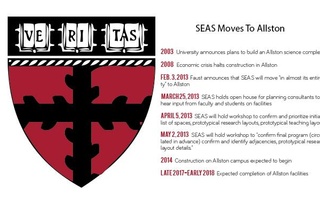Harvard’s School of Engineering and Applied Sciences graduate students swept top honors at the Collegiate Inventors Competition in Washington D.C. last week.
This year was the first in recent history Harvard took the top three places at the competition, which aims to foster innovation by recognizing young scientists and inventors.
First prize winner Alice A. Chen, a doctoral student at SEAS and member of the Harvard-MIT Health Sciences and Technology Program, won $15,000 for her work on engineering human liver implants in mice.
Chen’s invention is a specialized cell matrix, which includes functional human liver cells along with the nutrients needed for the cells to grown, and may enable scientists to generate functioning human livers in mice.
The benefits of this innovation include providing medical researchers with improved mouse models for drug testing.
Postdoctoral researcher Erez Lieberman-Aiden took second place and $10,000 for developing Hi-C, a technology which helps scientists understand how genomic DNA folds in the nucleus of a cell.The technique, which has already attracted attention in the field of genomics, may also benefit researchers studying genome-related diseases like cancer.
Former SEAS graduate student Bozhi Tian, now a postdoctoral fellow at MIT, and SEAS graduate student Itzhaq T. Cohen-Karni were awarded $5,000 and third prize for their work on electronic cell probes.
Tian and Cohen-Karni developed an intracellular probe using three-dimensional silicon nanowires that, when inserted into a cell, act as field-effect transistors, which monitor electrical signals in the cell to show how fundamental cellular processes occur.
Since its inception in 1990, the competition has awarded over $1 million to winning finalists through partnerships with government, industry, and academic organizations.
Harvard graduate students took top prize in 2008 and 2009.
Area Dean for Applied Mathematics Michael P. Brenner noted the competition’s results reflects Harvard’s efforts to expand interdisciplinary collaboration between the pure and applied sciences.
“There are a lot of inventive graduate students in SEAS and I am glad to see their efforts be recognized,” Brenner said.
Read more in News
Former Afghan Ambassador Appointed Fellow at Harvard Kennedy SchoolRecommended Articles
-
SEAS Dean To Hire FacultyHarvard’s School of Engineering and Applied Sciences (SEAS) Dean Cherry A. Murray discussed the future of SEAS during her second “All-Hands Meeting” yesterday afternoon, where she presented plans to tap into the school’s financial reserves to fund continued faculty and staff growth.
-
Engineering a CurriculumWe are glad to see SEAS taking concrete steps to actualize its plans to expand Harvard’s engineering program.
-
The Tantrum Over EngineeringIf faculty members were truly worried about students bearing an overly heavy course load, they would have made a fuss about it during the five years that engineering sciences itself has been a concentration.
-
Computational Science And Engineering Introduces Masters ProgramsFor the first time, the School of Engineering and Applied Science is accepting applications for its new graduate degree programs in Computational Science and Engineering. Students can now apply to pursue a Master of Science or a Master of Engineering in the field.
-
Lacking Space, SEAS Plans Allston ExpansionAs the School of Engineering and Applied Sciences awaits its planned move across the river to Allston, the school is in search of short term solutions to immediate problems created by a lack of space.
-
 As SEAS Moves to Allston, Administrators Contemplate Schedule Changes
As SEAS Moves to Allston, Administrators Contemplate Schedule Changes













